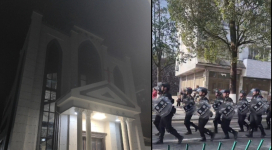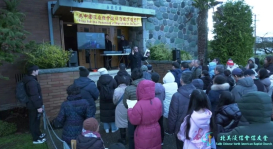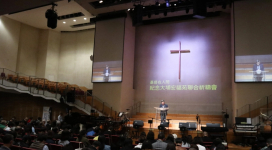PHOENIX, Ariz. — A majority of Protestant pastors predict that the influence of Christianity in America will decrease over the next ten years, according to a new nationwide study.
The study, by Ellison Research of Phoenix, showed that many pastors think that there will be a corresponding increase in the influence of non-Christian religions and “New Age” spirituality.
Baptist and Lutheran clergy tended to be the most pessimistic about Christianity’s influence, while Pentecostal and charismatic pastors tended to be more optimistic about the next decade.
The survey polled 567 Protestant pastors about their expectations concerning the Christian faith in America a decade from now. While pastors were widely split over how different things will be in the church in the year 2012, 82 percent agreed that “the influence of non-Christian religions in the U.S.” would increase in the coming decade. Only 5 percent thought there would be a decrease in non-Christian influences, and 13 percent said they did not expect things to be much different 10 years hence.
Similarly, 55 percent of all ministers said they believe there will be an increase in “influence of ‘New Age’ spirituality in the U.S.” Twenty-six percent predicted no changes in New Age influence, while 19 percent believed New Age influence would actually decrease over the next decade. Evangelical pastors in general were far more likely to predict an increase in New Age spirituality—59 percent, compared to just 34 percent of pastors from mainline denominations. Younger ministers were also more likely to foresee an increase in New Age influence (71 percent of pastors under the age of 45, compared to 51 percent of those age 45 to 59, and 42 percent of older ministers).
Pastors were most pessimistic when asked about the future of the “overall freedom of religion in the U.S.” Ten percent predicted that freedom would increase and 46 percent said it would stay the same as today. However, 44 percent predicted declining freedom of religion in America over the next decade. Evangelical pastors were particularly pessimistic, while most mainline clergy expressed no great expectation of substantive change.
Most Protestant clergy were not optimistic about “the influence of Christianity in Americans’ daily lives.” Forty-one percent said they believe such influence will decrease, while 33 percent thought it would stay the same. Only 26 percent predicted that the Christian faith would influence Americans more in 2012 than it does today.
Pastors were even less likely to project a 10-year increase in “the influence of Christianity in national politics.” Nineteen percent predicted increased Christian influence in politics, 50 percent thought it would not change much, and 31 percent believed there would be a decline of Christian influence over the decade to come.
As to the future of churches in America, 33 percent of all ministers predicted an increase in “the proportion of Americans who attend a Christian church.” Another 23 percent felt there would be no change in church attendance among Americans, while 44 percent predicted that there would be a decline in church attendance.
Baptists and Lutherans were the groups most likely to anticipate a decrease in church attendance, while Pentecostals were more likely than other groups to predict that attendance would rise over the next decade.
While the predictions on church attendance by a high percentage of pastors were not encouraging, 35 percent still thought the number of Christian churches in the U.S. would increase over the next 10 years. Another 30 percent said they would stay somewhat constant, and 35 percent predicted that there would be a decrease. Pentecostal pastors were the most likely to be optimistic, with nearly half predicting an increase in the number of Christian churches.
Along denominational lines, 43 percent of all ministers said they thought the numbers attending their own denomination’s churches would increase by 2012, while 25 percent predicted no change, and 32 percent projected a decline.
However, there was a vast difference in optimism between mainline and evangelical clergy. Among mainline pastors, only 26 percent said they thought their denominations would grow, while 44 percent predicted a decline. Among evangelical ministers there existed an overall sense of optimism, with 48 percent predicting denominational growth, and only 27 percent projecting a decline in their respective denominations.
The Ellison researchers noted that churches which are part of the National Association of Evangelicals—which represents the majority of evangelical denominations—were particularly optimistic, with 70 percent predicting growth and just 14 percent projecting a decline. Pentecostal and charismatic pastors were particularly excited about the future, with 80 percent predicting that their denominations and fellowships would grow.
By contrast, ministers from denominations in the mainline National Council of Churches were far more pessimistic, with just 20 percent predicting growth and 54 percent expecting decreases. Methodist (22 predicting growth, 49 percent a decline) and Lutheran (25 percent for growth, 39 percent for decline) were the most pessimistic about the future of attendance in their denominations.
Finally, Ellison polled pastors on what they believe will happen with “the proportion of Americans who are believing Christians” over the next 10 years. Once again, predictions were mixed, with 34 percent saying that Christianity would experience growth, 29 percent predicting stability in numbers, and 37 percent anticipating a decline. Lutheran and Baptist pastors were the most pessimistic about the growth of the faith in the next decade.
Ron Sellers, president of Ellison Research and director of the study, noted that those pastors who were the most optimistic may want to take a closer look at national trends.
“Study after study reveals no real increase in church attendance, Bible readership, or Christian belief in the U.S. for many decades,” Sellers said. “It’s understandable that evangelicals tend to expect growth in their denomination, while mainline ministers often anticipate decline, because that is a continuation of well-established trends. But the pastors who predict overall increased church attendance or more Christian influence in people’s lives are apparently expecting the start of something new—something that, by all available measurements, isn’t currently happening in the U.S. and hasn’t happened for many years.”
By Christian Times







